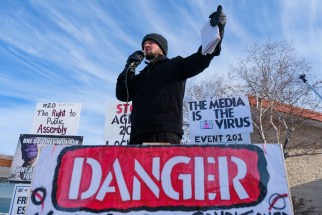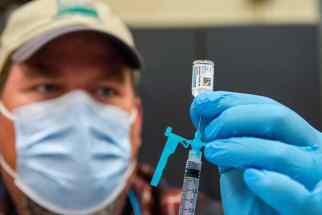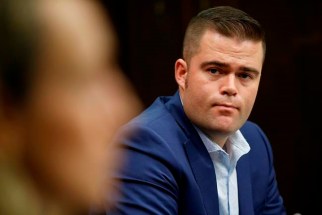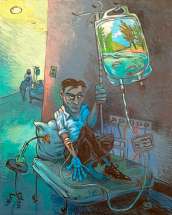Sharing shots: First Nations inoculate non-residents 'We do not discriminate against age, race or gender'
Read this article for free:
or
Already have an account? Log in here »
To continue reading, please subscribe:
Monthly Digital Subscription
$0 for the first 4 weeks*
- Enjoy unlimited reading on winnipegfreepress.com
- Read the E-Edition, our digital replica newspaper
- Access News Break, our award-winning app
- Play interactive puzzles
*No charge for 4 weeks then price increases to the regular rate of $19.00 plus GST every four weeks. Offer available to new and qualified returning subscribers only. Cancel any time.
Monthly Digital Subscription
$4.75/week*
- Enjoy unlimited reading on winnipegfreepress.com
- Read the E-Edition, our digital replica newspaper
- Access News Break, our award-winning app
- Play interactive puzzles
*Billed as $19 plus GST every four weeks. Cancel any time.
To continue reading, please subscribe:
Add Free Press access to your Brandon Sun subscription for only an additional
$1 for the first 4 weeks*
*Your next subscription payment will increase by $1.00 and you will be charged $16.99 plus GST for four weeks. After four weeks, your payment will increase to $23.99 plus GST every four weeks.
Read unlimited articles for free today:
or
Already have an account? Log in here »
Hey there, time traveller!
This article was published 28/04/2021 (1688 days ago), so information in it may no longer be current.
Manitoba reserves have come to the rescue of non-Indigenous people who are waiting on the sidelines of a provincial COVID-19 vaccine rollout that’s one of the slowest in Canada.
“For First Nations people, kinship means a lot to us,” said Virginia Lukianchuk, who oversees the rollout at Sandy Bay First Nation.
“It’s difficult for First Nations people to tell people no.”
Like many reserves, Sandy Bay has offered doses to numerous non-Indigenous people who work on the reserve, and spouses of band members.
It also welcomed essential workers from the neighbouring town of Amaranth, whose residents use the same services as Sandy Bay residents, whether that’s in town or on the reserve.
Sandy Bay has 8,000 band members, and Lukianchuk said about 2,760 live on the reserve.
The band is struggling to use its first shipment of 1,600 Moderna doses before they expire on May 4. It has even invited off-reserve members to drive over for a shot, offered prizes and set up more vaccination days.
“For First Nations people, kinship means a lot to us… It’s difficult for First Nations people to tell people no.”
– Virginia Lukianchuk
Lukianchuk said offering shots to non-Indigenous people who work on the reserve or visit frequently also protects Sandy Bay residents.
“If the uptake in the community is low, we have to do everything we can to ensure that we are trying to provide some means of protection against the virus,” said Lukianchuk.
That generosity has been extended to others.
Two Winnipeg families with adult children who have special needs told the Free Press they registered with Sandy Bay for shots, and made the 180-kilometre drive to the reserve, despite not being Indigenous or having any ties to the community.
Lukianchuk said band staff who book appointments are supposed to screen out anyone who has no ties to the reserve.
She conceded that walk-ins might not have been asked that question, especially those who showed up for unclaimed, thawed doses that would otherwise be discarded.
“There might not have been proper screening, depending on who was working the door,” said Lukianchuk.
“We want to think outside the box on what’s best for our community.”
– Virginia Lukianchuk
She said the First Nations COVID-19 pandemic response team did raise concerns, but only about extending doses to first responders in neighbouring communities.
“They questioned some of the immunizations that we did, but we still stand firm on vaccinating all of our staff, within the community, regardless of if they are First Nation,” Lukianchuk said.
“We want to think outside the box on what’s best for our community.”
Another reserve that faced a backlash from the response team after it offered shots to non-Indigenous people was Long Plain. The reserve allowed residents of nearby Portage to get a shot even if they had no ties to the community.

The band said it didn’t regret its decision given that all Manitobans will have their chance at a shot in a few weeks.
The First Nations pandemic response team told the media three weeks ago that it was a mistake for Long Plain to go beyond the provincial criteria.
Dr. Marcia Anderson, who co-leads the First Nations rollout, said Wednesday it’s up to each reserve to decide how to use its doses.
“We are not a permission-granting body,” she told the Free Press.
“We encourage nations communities to follow the provincial eligibility criteria.”
“We encourage nations communities to follow the provincial eligibility criteria.”
– Dr. Marcia Anderson
Anderson said it makes sense to have off-reserve members get shots if it’s done safely, and noted the kinship many reserves have with their neighbours.
She refused to say whether it’s appropriate for non-Indigenous people to get vaccinated at a reserve with which they have no connection.
“I’m not going to comment on that specifically,” Anderson said.
Sandy Bay and Long Plain both said they struggled to get enough residents to roll up their sleeves, but that more people stepped up when news emerged about highly contagious variants of the virus.
Anderson said there has generally been great uptake on First Nations. She said it’s hard to get reliable data on how many band members live on their reserve.
“There were times when the number of doses that went out was higher than the actual on-reserve, 18-plus population, and that impacted the availability of extra doses,” she said.
Cross Lake, in northern Manitoba, has given first doses to 65 per cent of adults in the community of 8,000 people.
The band has been lauded for providing shots to teachers in Thompson, on the basis that many Cross Lake families live in the city and send their kids to school.
“Once the vaccines are released, they belong to us and they belong to our people,” said Cross Lake Chief David Monias.
“We do not discriminate against age, race or gender.”
NDP MLA Nahanni Fontaine said she’s proud of her Sagkeeng reserve for offering shots to teachers and essential workers in neighbouring Pine Falls, as well as truckers and Winnipeg animal-rescue volunteers.
“There are some folks that are hesitant to get the vaccine, so do you waste the vaccines, or do you pick up the province of Manitoba’s slack, and vaccinate non-Indigenous people,” Fontaine said.
“My community has shown, in a very real and material way, that now is the time to come together.”
For at least a month, Manitoba has been the second slowest of all 10 provinces at using the COVID-19 doses it has received, and dropped to last place this week.
Chief Nelson Genaille, of Sapotaweyak reserve on Lake Winnipegosis, said it benefits his people to offer shots to non-Indigenous people who visit the reserve for work.
“Their vaccination might not roll out until summertime,” he said.
“If you let one virus in, it just skyrockets. It just goes on and on, and it’s hard to control.”
dylan.robertson@freepress.mb.ca







